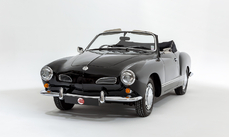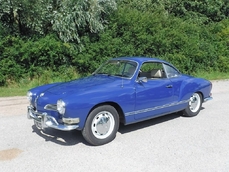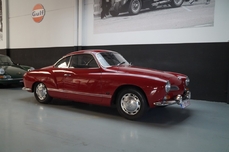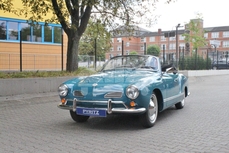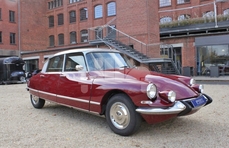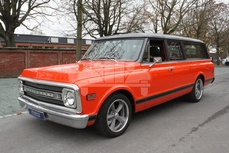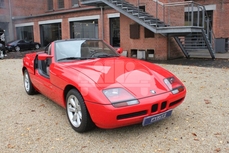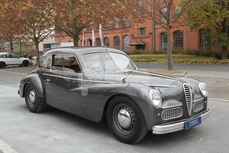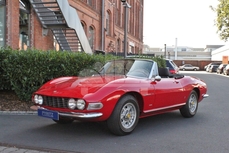Volkswagen Karmann-Ghia Low Light 1957
General description :
VW Karmann Ghia – ein Käfer im Galakleid
Volkswagen, Karmann und Ghia sind 3 Väter eines Projektes, das auf Bestreben von Wilhelm Karmann realisiert werden konnte. Die Idee: ein VW im Galakleid, sportlich und knapp geschnitten. Es war ein Auto zum Träumen – in einer Zeit, die das Träumen gerade neu entdeckte.
In den Osnabrücker Karmann-Werken wurde ab 1955 auf Motoren und Chassis der Wolfsburger VW Werke eine in Italien entworfene Karosserie gesetzt, die das Fahrzeug zum Schwarm Aller werden ließ. Im Herzen ein Käfer, symbolisierte es Lebensfreude, Sportlichkeit und genau den Spritzer Luxus, der den Nerv der Zeit zum Vibrieren brachte. Das Ergebnis: fast 500.000 Exemplare in knapp 20 Jahren Produktionszeit. Bedauerlicherweise hat der Rostfraß die meisten Fahrzeuge vorzeitig aus dem Straßenbild eliminiert. Lediglich in einigen südlichen Sonnenscheinstaaten haben Fahrzeuge überlebt, die nicht vom Salz und Wasser zerfressen wurden.
So gehört auch dieses ganz frühe , nur 2 Jahre nach Produktionsbeginn gebaute , seltene „ Low Light“ Coupé dank seiner US-Südstaaten Herkunft zu den wenigen Exemplaren, die weitgehend rostfrei überlebt haben.
Bitte beachten Sie hierzu auch die vielen liebevollen Details dieses 1957er Jahrgangs die diese „Low Light“- Coupè zum echten „ High Light“ machen.
Mit einem Arbeitsumfang von annähernd 1.000 Stunden wurde dieses Fahrzeug mit größter Sorgfalt nahezu vollständig auf sehr guter Basis sachgerecht restauriert. Die Restaurierung ist mit vielen hundert Fotos dokumentiert. Verwendet wurden zeitgenössische Glasurit Lacke: L352 cognac mit der Dachfarbe L472 beigegrau.
Für etwas mehr Durchzug sorgt die Oettinger Doppelvergaseranlage „Okrasa“ die zusätzlich 4 kw/6 PS liefert.
Selbstverständlich beinhaltete der Restaurierungsumfang die gesamte Technik einschl. aller Verschleißteile. Wir garantieren den einwandfreien technischen Zustand. HU und H-Kennzeichen sowie ein Wertgutachten des TÜV-Rheinland gehören zum Lieferumfang.
Gern unterbreiten wir Ihnen ein Angebot zur Inzahlungnahme Ihres bisherigen Klassikers.
Finanzierung-Leasing-Vermittlung über - http://www.abcfinance.de - möglich.
Änderungen, Irrtümer und Zwischenverkauf vorbehalten.
https://home.mobile.de/PYRITZCLASSICSGMBH#des_248391724
1957 Volkswagen Karmann-Ghia Low Light is listed sold on ClassicDigest in Frankfurt by Auto Dealer for €59500.
Car Facts
Car type : Car Make : Volkswagen Model : Karmann-Ghia Model Version : Low Light Engine size : 1.2 Model Year : 1957 Sub type : Coupé Location : Orberstr. 4aDE-60386 Frankfurt am Main
Sold
Seller Information
Sold
People who viewed this Volkswagen Karmann-Ghia also viewed similar Volkswagen listed at ClassicDigest
Other cars listed for sale by this dealer
About Volkswagen
The Volkswagen story is indeed an intriguing tale of innovation, resilience, and post-war revival, marked by various models that have become iconic in automotive history.The People's Car (Volkswagen): Initially envisioned by Adolf Hitler in the 1930s as a "people's car" or "Volkswagen" in German, the idea was to create an affordable and practical vehicle for the German people. This concept led to the development of the Volkswagen Beetle (or the Type 1), designed by Ferdinand Porsche.
Post-War Challenges: After World War II, Volkswagen faced significant challenges. The factory was heavily damaged, and the brand's association with the Nazi regime led to a lack of interest in the car in some regions.
British Intervention - The British Army & Ivan Hirst: The British Army took control of the factory in the immediate post-war period. Major Ivan Hirst, a British Army officer, played a crucial role in reviving Volkswagen. He recognized the potential of the Beetle and advocated for its production, convincing the British military to order several thousand cars. This decision helped jumpstart the brand's revival.
Export Success and the Beetle's Global Appeal: The Beetle gained popularity not only in Germany but also globally, becoming an icon of affordable motoring. Its simple, reliable design and unique appearance made it a favorite among consumers worldwide.
Model Evolution: Over the years, Volkswagen introduced various models alongside the Beetle, each contributing to the brand's growth:
Type 2 (VW Bus or Transporter): Introduced in the 1950s, it became an iconic symbol of the hippie movement in the 1960s, loved for its spaciousness and versatility.
Golf (Rabbit in the U.S.): Launched in the mid-1970s, the Golf (or Rabbit in the U.S.) marked a shift towards front-wheel-drive, modern design, and hatchback practicality, becoming a cornerstone of the brand's success.
Passat, Jetta, and Other Models: Volkswagen expanded its lineup with models like the Passat and Jetta, catering to different market segments.
Challenges and Innovations: Despite success, Volkswagen faced challenges, including quality issues in the 1970s. However, the brand continued to innovate and develop new models and technologies.
Rise of the GTI and Global Expansion: The 1980s saw the rise of the iconic Golf GTI, a high-performance version that sparked the hot hatch trend. Volkswagen also expanded its global presence during this period.
The British intervention in reviving Volkswagen after World War II played a pivotal role in the brand's resurgence. While there might have been some tensions or competition among automotive companies in the 1950s and 1960s due to Volkswagen's post-war success, the brand's ability to produce innovative and popular models solidified its place in automotive history.


